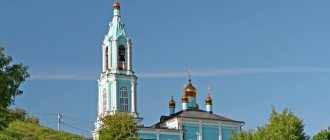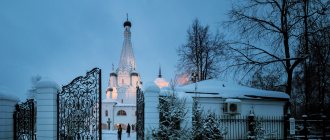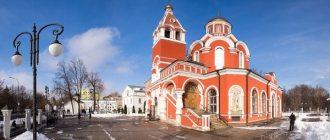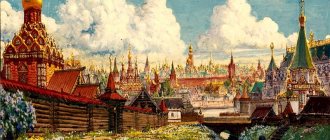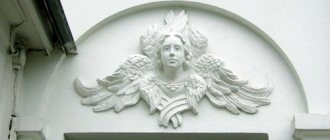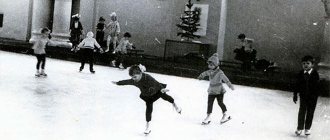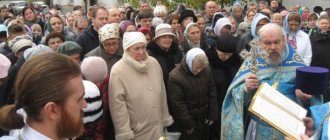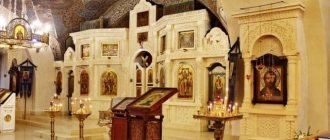Mir
Russia Moscow Temple of the Deposition of the Blessed Virgin Mary in Leonovo (Moscow) Map is loading…
{"format":"leaflet","minzoom":false,"maxzoom":false,"limit":50,"offset":0,"link":"all","sort":[""], "order":[],"headers":"show","mainlabel":"","intro":"","outro":"","searchlabel":"\u2026 \u0441\u043b\u0435\ u0434\u0443\u044e\u0449\u0438\u0435 \u0440\u0435\u0437\u0443\u043b\u044c\u0442\u0430\u0442\u044b","default":"","import-annotation":false,"width ":"auto","height":"350px","centre":{"text":"","title":"""link":"""lat":55.8414444000000003143213689327239990234375,"lon": 37.64424999999999954525264911353588104248046875,"icon":""},"title":"","label":"","icon":"","lines":[],"polygons":[], "circles":[ ],"rectangles":[],"copycoords":false,"static":false,"zoom":8,"defzoom":14,"layers":["OpenStreetMap"],"image layers":[] ,"overlays":[],"resizable":false,"fullscreen":true,"scrollwheelzoom":true,"cluster":false,"clustermaxzoom":9,"clusterzoomonclick":true,"clustermaxradius":80, "clusterspiderfy":true,"geojson":"","clicktarget":"","showtitle":true,"hidenamespace":false,"template":"","userparam":"","activeicon": "","pagelabel":false,"ajaxcoordproperty":"","ajaxquery":"","locations":[{"text":"\u003Cb\u003E\u003Ca href=\"/palomnik/%D0% A5%D1%80%D0%B0%D0%BC_%D0%A0%D0%B8%D0%B7%D0%BE%D0%BF%D0%BE%D0%BB%D0%BE%D0%B6% D0%B5%D0%BD%D0%B8%D1%8F_%D0%9F%D1%80%D0%B5%D1%81%D0%B2%D1%8F%D1%82%D0%BE%D0% B9_%D0%91%D0%BE%D0%B3%D0%BE%D1%80%D0%BE%D0%B4%D0%B8%D1%86%D1%8B_%D0%B2_%D0%9B% D0%B5%D0%BE%D0%BD%D0%BE%D0%B2%D0%B5_(%D0%9C%D0%BE%D1%81%D0%BA%D0%B2%D0%B0)\ » title=\»\u0425\u0440\u0430\u043c \u0420\u0438\u0437\u043e\u043f\u043e\u043b\u043e\u0436\u0435\u043d\u0438\u044f \u041f\u0440\u 0435\u0441\u0432\ u044f\u0442\u043e\u0439 \u0411\u043e\u0433\u043e\u0440\u043e\u0434\u0438\u0446\u044b \u0432 \u041b\u0435\u043e\u043d\u043e\u 0432\u0435 (\u041c\u043e\u0441 \u043a\u0432\u0430)\»\u003E\u0425\u0440\u0430\u043c \u0420\u0438\u0437\u043e\u043f\u043e\u043b\u043e\u0436\u0435\u043d\u043 8\u044f\u041f\u0440\ u0435\u0441\u0432\u044f\u0442\u043e\u0439 \u0411\u043e\u0433\u043e\u0440\u043e\u0434\u0438\u0446\u044b \u0432 \u041b\u0435\u 043e\u043d\u043e\u0432\u0435 ( \u041c\u043e\u0441\u043a\u0432\u0430)\u003C/a\u003E\u003C/b\u003E\u003Chr /\u003E\u003Ca href=\"/palomnik/%D0%A1%D0%B2%D0% BE%D0%B9%D1%81%D1%82%D0%B2%D0%BE:%D0%90%D0%BD%D0%BD%D0%BE%D1%82%D0%B0%D1%86 %D0%B8%D1%8F\" title=\"\u0421\u0432\u043e\u0439\u0441\u0442\u0432\u043e:\u0410\u043d\u043d\u043e\u0442\u0430\u0446\u0438\u044f\ »\u003E\u0410\u043d\u043d\u043e\u0442\u0430\u0446\u0438\u044f\u003C/a\u003E: »'\u0425\u0440\u0430\u043c \u0432 \u0447\u0435 \u0441\u0442\u044c \u041f\u043e\u043b\u043e\u0436\u0435\u043d\u0438\u044f \u0420\u0438\u0437\u044b \u041f\u0440\u0435\u0441\u0432\u044f\u0442\ u043e\u0439 \u0411\u043e\u0433 \u043e\u0440\u043e\u0434\u0438\u0446\u044b \u0432\u043e \u0412\u043b\u0430\u0445\u0435\u0440\u043d\u0435 \u0432 \u0431\u044 b\u0432\u0448\u0435\u043c\u0441 '' 3e\u0439\u0445\u0440\u0430 \u043c \u041c\u043e\u0441\u043a\u043e\u0432\u0441\u043a\u043e\u0433\u043e \u041f\u0430\u0442\u0440\u0438\u0430\u0440\u0445\ u0430\u0442\u0430; ""title":"\u0425\ u0440\u0430 \u043c \u0420\u0438\u0437\u043e\u043f\u043e\u043b\u043e\u0436\u0435\u043d\u0438\u044f \u041f\u0440\u0435\u0441\u0432\u044f\ u0442\u043e\u0439\u0411\u043e \u0433\u043e\u0440\u043e\u0434\u0438\u0446\u044b \u0432 \u041b\u0435\u043e\u043d\u043e\u0432\u0435 (\u041c\u043e\u0441\u043a \u0432\u0430)","link ":"","lat":55.8414444000000003143213689327239990234375,"lon":37.64424999999999954525264911353588104248046875,"icon":""}],"imageLayers":[] }
55.841599; 37.644216
Russia, Moscow, Dokukina street, 15с1
Moscow
Russia
Telephone:
(499) 181-01-41.
Temple in honor of the Placing of the Robe of the Blessed Virgin Mary in Blachernae in the former village of Leonovo
— parish church of the Moscow Patriarchate; Trinity Deanery.
History[edit]
The Levonov Heath was first mentioned in the scribe books of 1573–1574. In 1626, Leonovo was granted to Prince Ivan Nikitich Khovansky, who soon erected a wooden Church of the Deposition of the Robe on the very spot where the current temple stands. The first mention of it was in 1633.
Stone temple, built in 1719–1722. made of stone, was consecrated in 1722 on the day of the Feast of the Laying of the Robe of the Most Holy Theotokos (July 2, Art.).
The church was closed in 1800, and it “remained without singing until 1859,” falling into complete desolation. In 1812, Napoleon's troops desecrated the church by building a stable in it. In 1859, the manufacturer Molchanov, who had recently built the Rostokinskaya cotton-printing factory, renovated the temple for the spiritual needs of his workers.
After the October revolution, the Temple of the Deposition of the Robe was also attacked by the atheistic authorities. According to the agreement of December 17, 1918 between the district Council of Deputies and parishioners, the Leonovsky church was transferred to believers for free use. In the same year, a significant number of icons and, mainly, church utensils were transferred to the Leonov church from the St. Michael's Church of the Grodno diocese. During the Great Patriotic War, the temple made large contributions to the Red Army fund. There is evidence that in different years the temple was visited by Moscow Patriarchs: Alexei I, Pimen, Alexei II.
Several icons of old writing have been preserved in the church, probably transferred from a wooden church of the 17th century. These are two identical in size, picturesque style of writing and design of the image of the Virgin Mary from the beginning of the 18th century. - “Quench my sorrows” and Kazansky, located one opposite the other at the side walls. The temple image of the “Position of the Honorable Robe of the Mother of God” was made in oil in the 19th century.
In the Church of the Deposition of the Mother of God in Leonovo in the 20th century, wonderful shepherds served in different years, who made a significant contribution to the strengthening of Orthodoxy on Russian soil. Thus, after the end of the war, the future elder schema-abbot Savva (Ostapenko, 1898–1980), who labored in the Pskov-Pechersky Monastery during the Soviet years, served as an altar boy in the church.
History of the temple
The Leonovskaya Heathland was first mentioned in the Scribe Books of 1573-1574. In the first half of the 17th century, Prince Ivan Nikitich Khovansky became the owner of these lands, who built a wooden church here in honor of the Deposition of the Blessed Virgin Mary. The structure was erected between 1629 and 1635. The church was local - the owners of the estate paid the clergy a salary in the form of loose bread (wheat), since the population of the village was small due to the raid on Moscow by the Crimean Tatars in the 16th century, there were practically no parishioners.
Construction and foundation
In 1716, Leonovo was inherited by Prince Vasily Petrovich Khovansky, who in the future became a chamberlain, but for now he was a young rake, a chick of Petrov’s nest, he was addicted to alcohol and loved to “fool around” with friends. But one day it came to violating religious canons.
The friends got Vasily drunk to the point of unconsciousness and got very drunk themselves, then they put him in a coffin, took him to the temple, performed the funeral ceremony in a blasphemous manner and went home. The owner of the estate remained in the church until the local priest Philip Leontiev came early in the morning and brought him out.
The church servants reported this incident to Peter I in St. Petersburg. Having heard from Chancellor Shafirov about the incident, the tsar at first became very angry and gave the order to execute Vasily and all his friends, but then showed mercy and subjected the participants in the sacrilege to lashings in his personal presence.
After this incident, the prince, as a form of repentance, in order to somehow make amends for his offense before God and the Tsar, turned to the Holy Synod with a request to allow the construction of a stone temple on the Leonovo estate. But the decree came only a few years later, after the lifting of the 1714 ban on the construction of stone buildings everywhere except St. Petersburg. Therefore, construction could only begin in 1719.
In 1722, on the day of the Placing of the Robe of the Mother of God, the temple was consecrated by Archpriest Theodore Pankratiev and his brethren. The church has two chapels: in honor of the icon of the Mother of God “The Burning Bush” (September 17) and St. Nicholas of Myra the Wonderworker (his memory is celebrated on May 22 and December 19).
Historical fate
In 1767, naturalist scientist, entrepreneur and philanthropist Pavel Demidov became the owner of the estate in Leonovo. He laid out a beautiful park on the estate, for which he ordered rare trees from Siberia, built greenhouses, artificial ponds with many fish and birds.
In 1800, Demidov insisted on closing the temple because he suffered from a mental disorder and could not stand any noise, including the ringing of bells. Metropolitan Platon went to meet Pavel Grigorievich halfway, the iconostases and utensils were transferred to other monasteries. For more than fifty years, the shrine remained without worship, in a state of complete desolation. Trees didn't even grow on her roof.
In 1812, the cavalrymen of Napoleon's army, which entered Moscow, set up a stable for their horses in the temple, desecrating the shrine. In 1821, Demidov died, and his heirs sold the estate. In 1825, the merchant Kozhevnikov became the owner of the estate, on whose orders the entire forest and almost the entire park were cut down.
Reconstruction of the building
After 1859, the estate in Leonovo passed to the Kapustin family, and the church was revived again. The manufacturer Molchanov, who built a calico-printing manufactory nearby, wanted to undertake its restoration, and decided to prepare the temple for the spiritual needs of his workers. Presumably at this time frescoes were created on the outside on the side walls of the central cube.
The parishioners, most of whom were textile factory workers, could see in the space under the dome a copy of Ivanovo’s image “The Appearance of Christ to the People,” which was brightly illuminated by the sun’s rays.
In 1918, the Soviet government decided to transfer the temple to parishioners free of charge. St. Michael's Church of the Grodno Diocese donated many icons and church utensils to the parish. Some holy images are still in the monastery to this day: the Feodorovskaya icon of the Mother of God at the left choir in the main church and the image of the “Three Joys” in one of the chapels.
In 1922, the authorities seized all valuables from the Leonovsky Temple. During the times of persecution from 1931 to 1937, the rector was priest Pavel Felitsyn. In 1937 he was sentenced to 10 years in prison and sent to a camp. The priest died in 1941. The Council of Bishops of the Russian Orthodox Church in 2000 glorified Father Paul among the new martyrs and confessors of Russia. Orthodox Christians and parishioners of the church in Leonovo celebrate his memory on January 4 (17).
As is known, in the Soviet Union a policy was pursued of denying faith in Christ and state atheism was implanted everywhere. Therefore, most likely, no services were held in the period 1930-1942.
From 1942 to 1955, the rector of the temple was Archpriest John Markov. During his ministry, some transformative changes took place: new electrical wiring was installed, water heating was installed instead of a stove, the icons were restored, and a chandelier was purchased. During the Great Patriotic War, the parish regularly provided material assistance to the Red Army.
Current state
Nowadays, all that remains of the Leonovo estate is a pond, a small linden alley and a two-story house, which has completely lost its former appearance.
Today, a Sunday school for adults and children is open at the temple. Parishioners can visit the church library. There is also a granite workshop where tombstones are made.
Under the patronage of the temple are the Institute of Gerontology, Central Clinical Hospital No. 2 named after. Semashko and hospice No. 4. Clergy and parishioners work at the Yaroslavsky Territorial Center for Social Services (Rostokino branch) and the correctional institution IZ-50/8 of the State Penitentiary Service of the Moscow Region.
During the V Moscow Easter Festival, the “Ringing Week” was held in the Church of the Deposition of the Robe of the Blessed Virgin Mary in Blachernae.
The rector of the temple is currently Archpriest Andrei Rakhnovsky. In addition to him, priests Roman Kolesnikov and Sergiy Vinogradov, and deacon Alexey Arefiev are serving.
Clergy of the Leonovskaya Church also serve in assigned churches:
- Fedorovskaya Icon of the Mother of God at the Russian State University of Social Sciences (Moscow, metro station "Botanical Garden", Wilhelm Pika St., 4, building 1).
- Saints Reverend Anthony and Theodosius of Kiev-Pechersk in Bibirevo (Moscow, metro station "Altufyevo", Korneichuka St., 52a).
Current state[edit]
Interior decoration
Description[edit]
Built of stone and brick, plastered. It consists of an octagon-type temple on a two-height quadrangle with a rectangular apse, a two-aisle refectory and a bell tower. The original facade decoration (corner pilasters, profiled cornices with so-called crackers on the quadrangle and a number of small panels on the apse) is supplemented by plaster trims with “ears”, as well as external wall paintings dating back to the restoration of the church in 1859, carried out at the expense of the manufacturer Molchanov for the needs of the workers of the Rostokinskaya cotton-printing manufactory, located nearby. At the same time, apparently, the refectory was somewhat expanded and the upper tier of the bell tower was erected. In 1859, iconostases and interior paintings were completed.
Parish life[edit]
The church operates a Sunday school, courses in icon painting and singing.
Social service work is being carried out, and an Orthodox youth club is operating.
The illustrated magazine “Leonovsky Blagovestnik” is published monthly.
Every Monday evening, conversations are held with parishioners.
Scheme of Leonovsky cemetery
Telephone
+7.
In the church at Leonovskoye Cemetery you can perform the following rituals and sacraments:
- unction;
- confession;
- Communion at home or in the hospital.
When organizing an Orthodox funeral using Ritual.ru, you can send a note of repose, order services and requests:
- funeral service at home and in church;
- funeral service in absentia if the body of the deceased is missing;
- funeral service;
- forty
For an Orthodox burial, a special ritual set is selected:
A veil (shroud), a halo on the head, a cross on the body, a cross in the hand, a sheet with a prayer of permission, an eight-pointed gravestone cross.
Shrines[edit]
Reliquary
- Reliquary in the right corner of the central aisle
- Revered icons of the Mother of God “Laying of the Robe” (with a particle of the Robe of the Mother of God), Smolensk (16th century), “Three Joys”, Feodorovskaya, “Assuage my Sorrows”, Kazan, “Quick to Hear” from Athos, icon of the Great Martyr. Panteleimon from Athos
- Reliquary cross
- Ark with the relics of St. John of Shanghai and San Francisco the Wonderworker
- Icon of the Holy Blessed Matrona of Moscow with relics
- Icon of the holy confessor Nicholas of Alma-Ata with relics
Divine service
Daily: Divine Liturgy at 9 o'clock; Evening Worship at 17:00.
On Sundays and Holidays: Divine Liturgy at 7:00 and 10:00, the day before - All-Night Vigil at 17:00.
Summer schedule: from July to September on Sundays and Holidays there is one Divine Liturgy at 9 a.m.
Divine services (Lent): all statutory services of Great Lent are performed.
Sunday school: the church operates a Sunday school and a parish library.
The clergy of the temple care for the patients of the Institute of Gerontology, hospice No. 4, Central Clinical Hospital No. 2 named after. Semashko.
How to get there[edit]
Located in the North-Eastern administrative district of Moscow, Rostokino district, at Dokukina street, building 15, approximately three hundred meters southeast of the Botanical Garden metro station.
Close to the temple is the modern Leonovo park area, where the remains of the park's linden alley and a decorative pond have been preserved. The park was laid out in the second half of the 18th century, when the village of Leonovo belonged to the Demidovs, and was landscaped in the summer of 2007. In the park there are stands with a brief history of the temple. Also in the immediate vicinity is the Yauza River, across which there is a pedestrian bridge not far from the temple.
Address:
129226, st. Dokukina, 15с1, metro station "Botanical Garden".
Telephone:
(499) 181-01-41.
Directions:
- by public transport: metro station "Botanical Garden", last car from the center, 5 min. walk through the park towards the street. Dokukina
- by car: Turn from Prospekt Mira onto st. Dokukin, at the cemetery turn left and go to the end.
Church architecture
The unique ancient shrine is built like an octagon and is adjacent to:
- rectangular apse;
- two chapels in the refectory;
- a bell tower decorated with ancient bells, the chimes of which send crimson chimes into the sky of Moscow.
Leonovsky Temple, as an architectural monument, with the “Garden of the Future” park restored in 2004, attracts tourists and pilgrims from all over the world.
A white stone arch greets every believer passing here. The Leonovo shrine, made in the Baroque style, still delights with the beauty of its facades and the splendor of its decoration.
Temple priests[ | ]
Deceased clergy of the temple Position of the robe of the Blessed Virgin Mary in Leonovo
- Priest Paul (1646)
- reader Emelyan Eremeev (1646)
- Priest Rodion Ivanov (1678)
- Priest Meletius Provov (1703)
- Priest Philip Leontyev (1705-1728)
- Priest John Alekseev (1729)
- Priest Konstantin (1859-1870)
- Archpriest Joakim Smirnov (1871-1917)
- Priest Vladimir Smirnov (1918-1929)
- Deacon Stefan Remizov (1917)
Hieromartyr Pavel Felitsyn, presbyter of Leonovsky (1931-1937) was canonized in 2001.
- Priest Vasily Remizov (1937)
- Archpriest John Markov (1942-1955)
- Schema-abbot Savva (Ostapenko) (1945) (was an altar boy)
- Archpriest Viktor Ippolitov (1955-1960)
- Archpriest Eros Yasenchuk (1960-1964)
- Archpriest Stefan Nemerishin (served as regent)
- Archpriest Boris Egorovsky (1964-1976)
- Archpriest Valentin Tyurgashkin (1976) † 2000
- Archpriest Arkady Stanko (1981)
- Archpriest Anatoly Tsvirkunov (1986-1992)
- Archpriest Viktor Ivanov (2001)
- Priest Andrey Grachev (1992-1997)
- Hierodeacon Hilarion (Babyshev) (1980-1990)
- Deacon Benjamin (2000)
- Priest Vyacheslav Trusov (2005-† 2012)
- Priest Arkady Goglov (2001-† 2013)
- Archpriest Anatoly Stadnyuk (1990-2004)[10] † 2014
- Archpriest Gennady Nefedov (1976-1981) † 2021
